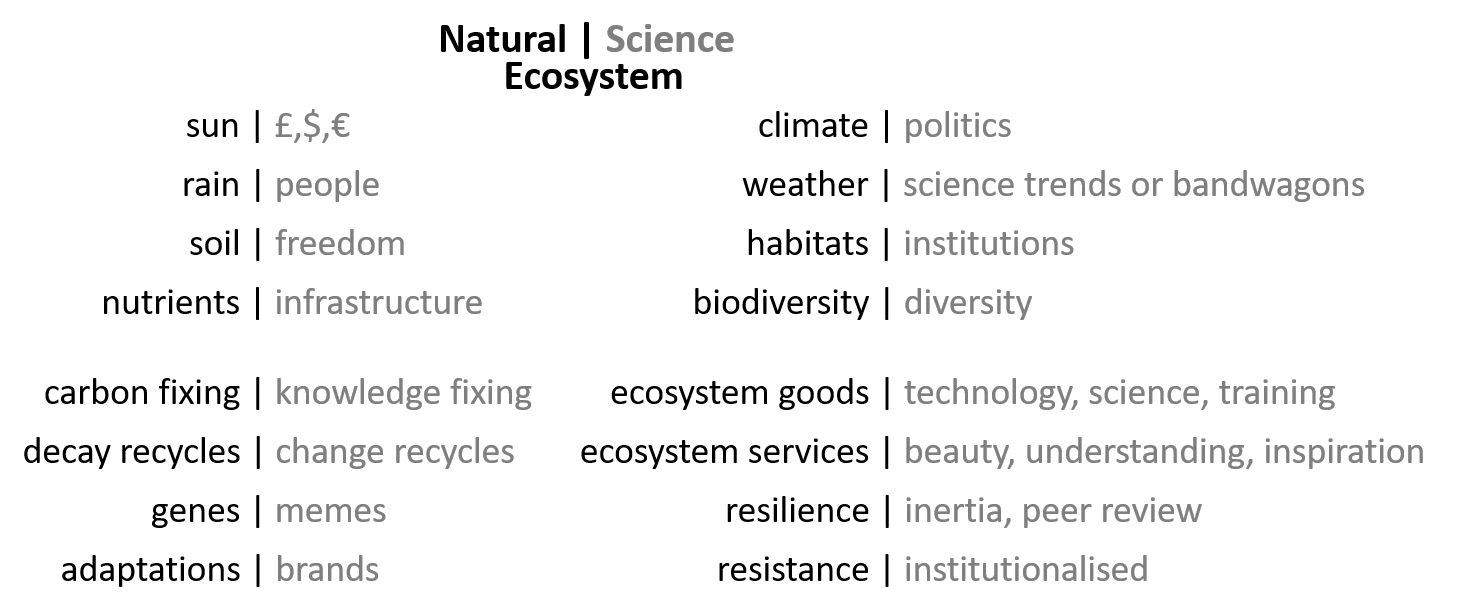The analogy between science and an eco-system is fruitful in explaining certain features of the system of science. As a result there are various terms which can be explicitly compared. Suggestions and comments can perhaps uncover many more.
Many of these seem to fit nicely, while others could be discussed and varied. In the book I advance why funding powers everything in the science world, just as sunlight does for almost all ecosystems on earth. The flow of people through science, from taking a curious interest at an early age, to deepening knowledge and then developing through specialisms in industry or academia to different careers, is like the flow of H2O from the oceans, through clouds to rain and then flow down streams and rivers to collect in different parts of the ecosystem. More contentious might be soil that sustains all plants, that I imagine as the conditions under which science can be fostered and of which freedom is an important aspect (but not the only one).
Primary production of organic matter from inorganic sources literally brings the world to life. Fixing into flesh and pulp the carbon locked up in gaseous CO2 underpins everything. In science, perhaps the best equivalent of this alchemy is the conversion of messy research into well-defined knowledge, mostly in the form of papers but also as know-how or novel instruments.
Nutrient cycling describes an important constraint in bio-ecosystems, setting how rapidly carbon in dead biomass is recovered back into nutritious fodder for plants and microbes. Slow cycling locks up resources, and reduces the pace of evolution until overcome by some adaption. Such cycles are also present in the circulation of knowledge, with new generations of scientists trained by elders who pass on their passions, their ways of doing things, and their idiosyncrasies. Institutes are infrastructures that are slow to recycle, requiring such significant resources and leadership to set up and maintain, that they become rigid structures sequestering funds. Rarely are they killed to release these (as in existential struggles of industry), but more politically expedient is a morphing of their missions. Another form of cycling is that of abstruse scientific knowledge into more digestible fragments. Fertile concepts can then be used in other science fields, seeding new ideas far removed from their origin. It is no coincidence that all these cultivation metaphors are embedded already in the discussion of science.
Habitats for science are all the niches where it prospers and thrives, hence the institutions in which it is embedded, from universities to the inventor’s garage. Their topography is akin to the landscape of institutions within science. They are also affected by the local water run-off (local skills available), nutrients (infrastructure) and affected by the climate. Even though our climate is physically-derived, it can be affected on a sluggish global scale by the biosphere as well. In a similar way climate is well described by politics in its broadest sense, which is very slowly influenced by science (at least at the moment) but sets the overarching context in which it operates.
Many other concepts that would be interesting to explore with the science ecosystem are keystone species, speciation rates, sex and reproduction, phenotype and genotype, mutation, wetlands, microclimate, systems ecology and intervention, toxicity, and taxonomy.
